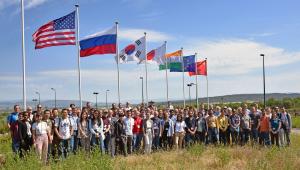EPICS
An arena for cooperation
10 Jun 2019
-
Ralph Lange, CODAC Section
Like the system of nerves in the human body, ITER's control system will connect the ITER "brain" (control room systems) to its eyes and ears (sensors and diagnostic systems) and its muscles and intestines (magnets and conventional systems). Implementation takes the form of a free and open-source software package called EPICS (Experimental Physics and Industrial Control System) that has evolved over 30 years of use by scientists around the world.
Developers and managers from many user sites around the world converged on ITER from 3 to 7 June 2019 for the spring EPICS collaboration meeting.
EPICS software is used to create distribute soft real-time control systems for scientific instruments such as particle accelerators, telescopes, experiment beam lines, and other large scientific instruments.
Two times a year, EPICS collaboration meetings offer developers and managers from the various sites the opportunity to report progress, share experience and discuss ideas for future development. Users are given the chance to see what is being done at other laboratories, and to review the specifications for new tools or enhancements in order to maximize their usefulness to the entire community and avoid duplication of effort. Hosted by an institute using EPICS—and alternating between Europe, the United States and the Asian-Pacific region—meetings usually last five days and include workshops on special topics and training sessions.
Last week, for the first time in 10 years, it was again ITER's turn to host an EPICS collaboration meeting. Just over 100 participants from 43 institutions converged on ITER to convert the ITER amphitheatre into an arena for the exchange of knowledge and ideas.
From more than 60 presentations during the main meeting, participants took home notes full of new ideas and possible solutions for their systems. Anders Wallander, head of the ITER Control System Division, points out the advantages: "ITER is an active participant in the EPICS collaboration and the face-to-face collaboration meetings provide an opportunity to build relations and align development and testing efforts, with associated cost savings for all parties."
The Control System Division used the opportunity to show the EPICS community how ITER plans to use the latest developments. A guided tour of the construction site and demonstrations of the virtual reality room completed the meeting program. As Anders Wallander puts it: "By hosting the EPICS collaboration meeting, ITER benefits from raising the awareness of the project in the worldwide control community and may attract talented future staff."


